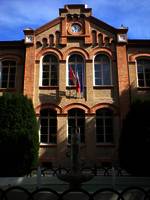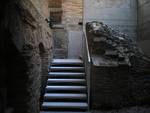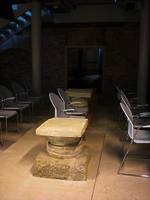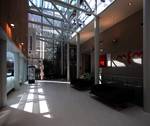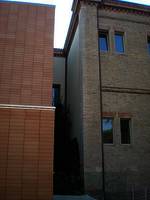The building
The building now housing the Mediateca Montanari – Multi-media library – was designed by the architect Giuseppe Balducci. The building was constructed using recycled materials from the demolished monastery of San Filippo, which had stood on the same site. The building was constructed between 1899 and 1903 in the typically eclectic style of the time. From the early 20th. century to 1998 it was home to the elementary (primary) school Luigi Rossi.
Once work on the building had been completed, the Mediateca Montanari was inaugurated on 10th. July 2010.
Restoration
The architects and engineers responsible for restructuring the building were co-ordinated by Professor Giampiero Cuppini. The principal aim of the group was to retain and enhance the aspects of historic interest. The former school building and archaeological site were therefore preserved and incorporated into the new multi-media library. The building was remodelled without altering the layout of the ten large rooms and two corridors now housing the library.
Outside stairs were modified to reveal part of the mediaeval foundations of the abolished monastery of San Filippo. The steps are visible from the terrace of the bar looking onto this small section of the foundations.
The sala ipogea beneath the entrance hall is used for conferences and as an information point on the archaeology of the site for school groups and tourists visiting Fano romana.
The columns of the peristilio can also be seen here, free of the earth and enclosing tunnel which had hidden them from view.
The foudations may be observed through a glass floor which can be walked across, giving an idea of the extent of the temple, and the various building techniques employed.
The containment wall delimiting the garden inside is broken by an eyelet at the level of the columns, to indicate the continuation of the peristilio. Above this is a glass floor offering a view into the room. The row of columns is also visible from the entrance, through a glass floor protected by a blind.
Design
The idea of a new library for Fano had existed since 1999, both because the existing library, the biblioteca Federiciana, had little space left for new acquisitions, and in particular because of the need to supply the new services the public require, which it would have been impossible to concentrate in a single building. While the Federiciana remained the library for research and conservation, the former Luigi Rossi school building became available for the Memo to grow as a multimedia and general information library, thereby creating the Library Network of the City of Fano.
The existence of the new library was made possible thanks to the financial support of the Fondazione Montanari.
The steel supporting structure of the new building is free-standing. Two small garden spaces create a visible connection between this inner structure and the outside walls of the building, thus creating a single environment.
This new multifunctional space is welcoming and recreational, offering: information point, caffeteria, interior courtyard garden, stairs to the ipogea and archaeological finds, and a balcony looking onto the inside ‘piazza’.
The glass sides and roof of the new structure illuminate the extension and archaeological site.
The entrance hall offers a view of the ipogea through a glass floor placed over a branch of the peristilio.
The corridors and rooms containing books and internet connections provide not only places to study, but also convenient points to surf the net and listen to music, and comfortable armchairs to sit in and read.

Archaeology
The 1899 demolition of the great buildings of the San Filippo monastery complex meant that an entire area in this central position was opened up for investigation, then as now. Excavation brought various architectural structures to light (for the most part now reinterred), sculpture (on view at the Museo Civico), inscriptions and decorative cornices.
The Mediateca Montanari – MeMo – stands on an important ancient Roman site in central Fano, of which notable structures are still visible beneath the former Luigi Rossi school, now the Mediateca.
According to recent studies by Professor Sandro De Maria (Bologna University), the area was extensive and surrounded by porticos of stuccoed brick columns with limestone tuscan order bases and capitals. This may have been an area for spectators on performance days connected to the theatre nearby.
The complex was built at the end of the first century B.C.
Later, during the reign of the Emperor Claudius (41-54 A.D.), an imposing structure was erected on the east side of the quadrilateral portico, dedicated to the cult of the emperor. The building consisted of a large hall, the floor and walls sumptuously cladded in polychrome marble, with a portico and pronao (vestibule) and perhaps four corinthian columns at the front facing the Decumanus Maximus, one of the main Roman city streets, corresponding to the present-day Via Arco d’Augusto.
The images connected with this cult were statues of Claudius, his young son Britannicus and other members of the imperial family. The cult was widespread over the entire Ancient Roman world.
(Translation: Angela Gibbon)


